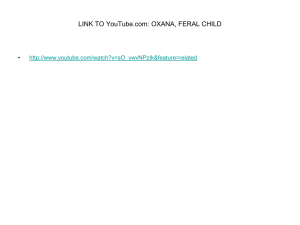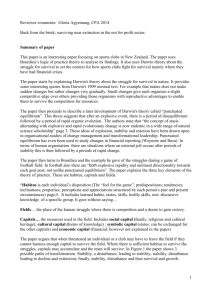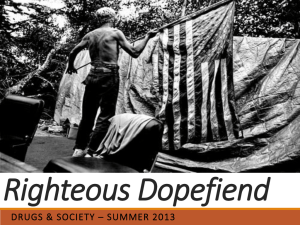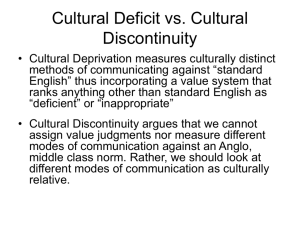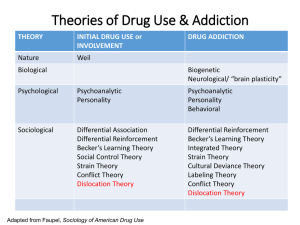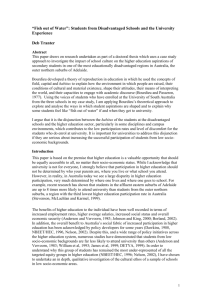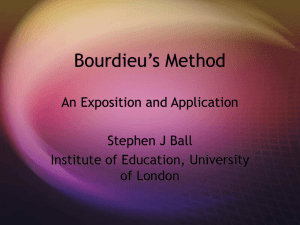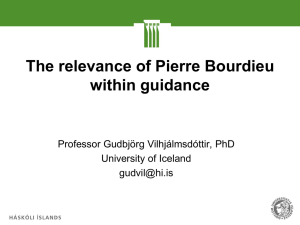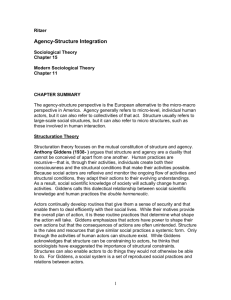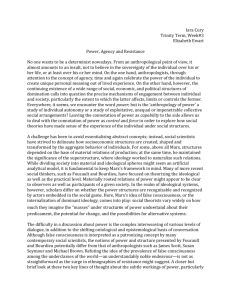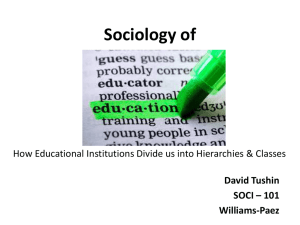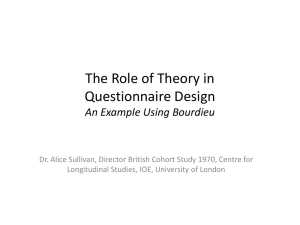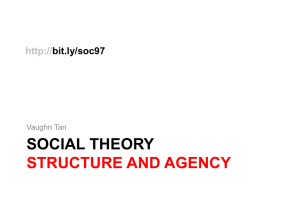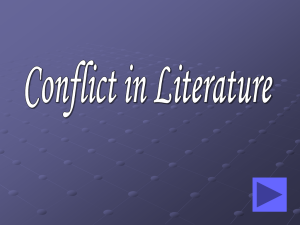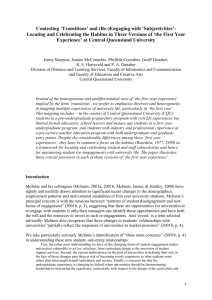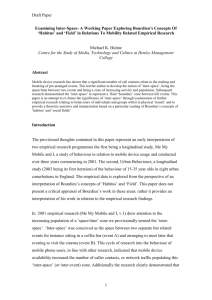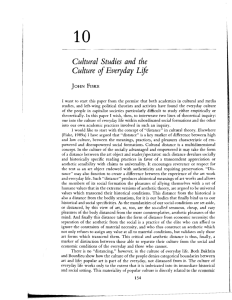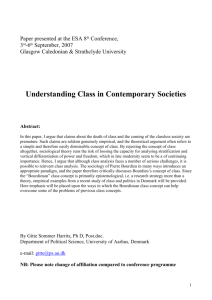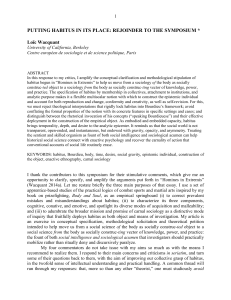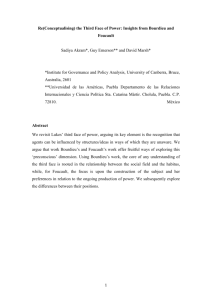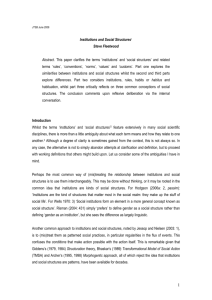19 Bourdieu II SP 2012
advertisement
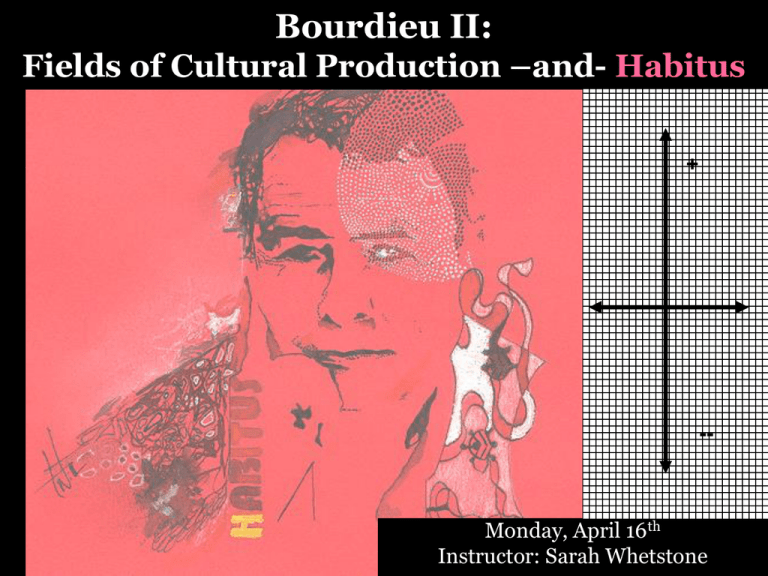
Bourdieu II: Fields of Cultural Production –and- Habitus + -- Monday, April 16th Instructor: Sarah Whetstone Readings and Key Concepts • “The Field of Cultural Production, or: The Economic World Reversed” – Art/literature as fields of cultural production – Fields in relation to other fields – Fields as sites of struggle • More on habitus! • Class Activity: “Homeless in El Barrio” – by Philippe Bourgois, in The Weight of the World (Bourdieu) What is Art?... some popular answers • “Internal reading” – Art is given significance through reference to other works of art or periods of style • “External reading” – Art is produced for consumer demand • “Art as pure creation” – Art is a pure expression of the artist’s creative intention • “Reductionist vision” – Art is merely a reflection of dominant class interestes and aesthetics (Ruling Class, Ruling Ideas perspective) • Bourdieu: Art is a field of struggle! Artists occupy distinct social positions with access to capitals that shape both the kind of art they make and how much power they have in the field of art. The Field of Art and Literature The capital one possesses determines status and position in the field “The structure of the field is … nothing other than the structure of the distribution of the capital of specific properties which governs success in the field and the winning of the external or specific profits (such as literary prestige) which are at stake in the field” (291). Economic, social, cultural, or symbolic capitals, which people have different levels of access to Actors struggle within the field to obtain and mobilize the capitals required to maintain and defend their positions. Art and Social Capital “[The making of] literary or artistic works, is inseparable from the space of literary or artistic positions defined by possession of a determinate quantity of specific capital (recognition), and at the same time, by occupation of a determinate position in the structure of the distribution of this specific capital” (291). Art and Cultural Capital •How, in the clip, was cultural capital displayed? •In this example, how might cultural capital distinctions reinforce class positions? •Can you think of an example where language is a major form of cultural capital, in another field? Relational Sociology: Fields within Fields • Fields are situated in relation to other fields • Relative space both within fields and between fields • Fields are “autonomous” to the degree that they follow an internal logic operating independent of other fields. • Bourdieu argues that art is situated within a field of power relations, itself situated in a field of class relations. • What does this mean for how art gets produced? How does it affect the value we attach to art? • “Art for art’s sake” vs. Commercial art (293) + POWER + --- + --- ART --- Field of Class Relations --- + Field of Forces, Field of Struggles • The literary or artistic world is a field of forces– positions and position-takings • Also a field of struggles– contestation over meaning, value, and claims to legitimacy. Actors in the field must defend their positions. • The strategies people use to defend their positions in the field depends upon their position in the field of power relations • “What can be constituted as a system for the sake of analysis… is the product and prize of a permanent conflict… the unifying principle of this system is the struggle” (292). Struggles for Dominant Principles of Hierarchization in Art and Literature • Heteronomous principle – Favored by economic and political elites – Bourgeois art, art for commercial production, commodification of art • Autonomous Principle – Art for art’s sake – Audience is other producers (other artists or writers) – Pursuit of business devalued– profit not important, independence from economy emphasized – Pursuit of power devalued– condemns honors and status distinctions – Pursuit of professional credentials devalued– lack of training considered a good thing – Failure gets recognition, success seen as “sign of compromise” The Struggle Continues… • Autonomous artists with high levels of “specific capital” face pressures of cooptation from heteronomous artists. • Heteronomous artists with low levels of symbolic capital align themselves more readily with the interests of economic and political elites. • The struggle is about imposing the legitimate definition of art and literature: “Who is legitimately entitled to designate legitimate writers or artists?” (295) • Struggle is not stable– ongoing struggle for the right to claim legitimacy. Historically contingent, socially contextualized. The Struggle to Define the Artist: Who is really an artist? Autonomous Producer– High cultural capital, questionable economic capital “We can't do anything to change the world until capitalism crumbles. In the meantime we should all go shopping to console ourselves.” — Banksy Heteronomous Producer– low cultural capital, high economic capital “There's been million-seller books and millionseller CDs. But there hasn't been, until now, million-seller art. We have found a way to bring to millions of people, an art that they can understand.” -- Thomas Kinkade Discussion: Positions, Practices, and Capital in the Fields of Cultural Production • Why does Bourdieu say that the fields of art and literature are so distinct from other social fields? (296-297) • Why, then, is there so much struggle to define authenticity or legitimacy in the art/literature world? (299) • What, according to Bourdieu, does an artist need to have to occupy an “economically risky” position, ie, to stop caring about economic concerns in the production of their art? (302) ~Habitus~ • The “site of interplay between structure and practice” – Links positions in social space with the particular practices actors within those spaces engage in • System of dispositions, shaped by early experience, that “generate & organize” practices throughout life, which become like enduring “habits” within the person • Habitus is deeply embedded within the person – Embodied – physically enacted! – Flexible and durable– guides patterned action, but also improvisation • The way society becomes deposited in persons in the form of lasting dispositions (tendencies toward action, thought, feeling) • Examples: Career expectations, who to marry, how to raise kids, whether or not to talk about politics at dinner… ~Habitus: Interplay between structure and practice Social positions in a field Habitus– deeply rooted, but flexible guidelines that “orient” the person toward a particular way of seeing and being in the world. HABITUS Practices: actions, behaviors, choices, etc. that signal your social position The habitus mediates between positions and practices. Understanding Habitus • Habitus captures the social as it operates through the physical body– Mostly active pre-consciously (p. 279, 286-7) • On 281, Bourdieu quotes Durkheim, saying “In each one of us… is contained the person we were yesterday.” Habitus is all of our past experiences, conditioned by the social environment, as they are expressed in our present practices. • Habitus tends to reproduce dominant structural relations– why? • Bourdieu’s notion of “social groups” cuts across class, race, gender, etc. to organize groups of people by similar types of “habitus” (283284). Multiple forms of experience shape the development of the habitus. – How does this notion of “social group” complicate Marxist and Weberian notions? Habitus is the way we see the world-- it shapes our expectations, hopes, and desires… “The art of estimating and seizing chances, the capacity to anticipate the future…or even to take a calculated gamble… are dispositions that can only be acquired in certain social conditions… Like the entrepreneurial spirit or the propensity to invest, economic information is a function of one’s power over the economy” (288). Group Activity: Habitus in “El Barrio” Using your copy of “Homeless in El Barrio,” apply Bourdieu’s theory of habitus to Ramon’s life. 1) Describe the social position Ramon inhabits– what is life like in El Barrio? Does Ramon have any economic, cultural, or social capital? 2) Describe Ramon’s “practices”– how does he behave, what actions or choices can we observe in the piece? 3) Describe Ramon’s “disposition”– how do you think he views the world? Link the development of Ramon’s habitus to his life experiences: How does Ramon’s everyday behavior reflect an embodiment of social structure? Bourdieu video links • Art is a social process • http://www.youtube.com/watch?v=ND7Ugj XHenY&feature=mr_meh&list=UU03HVuY jWXtfdQ7ewbghS5Q&lf=plcp&playnext=0 • Art and cultural capital – distinctions create boundaries • http://www.youtube.com/watch?v=FBn28i NcpBA&list=UU03HVuYjWXtfdQ7ewbghS 5Q&index=13&feature=plcp
